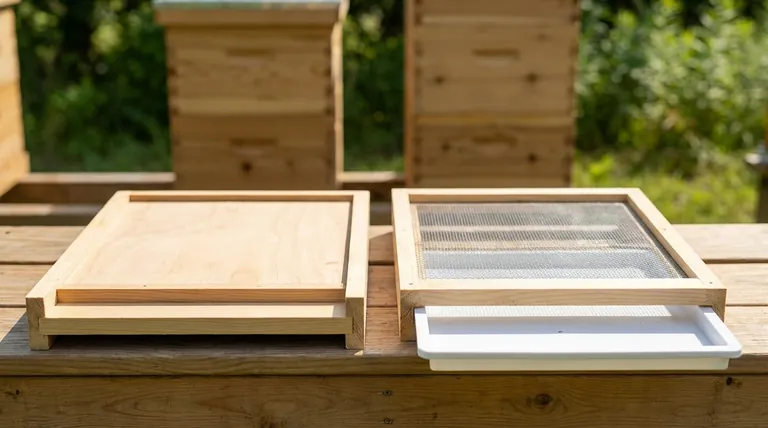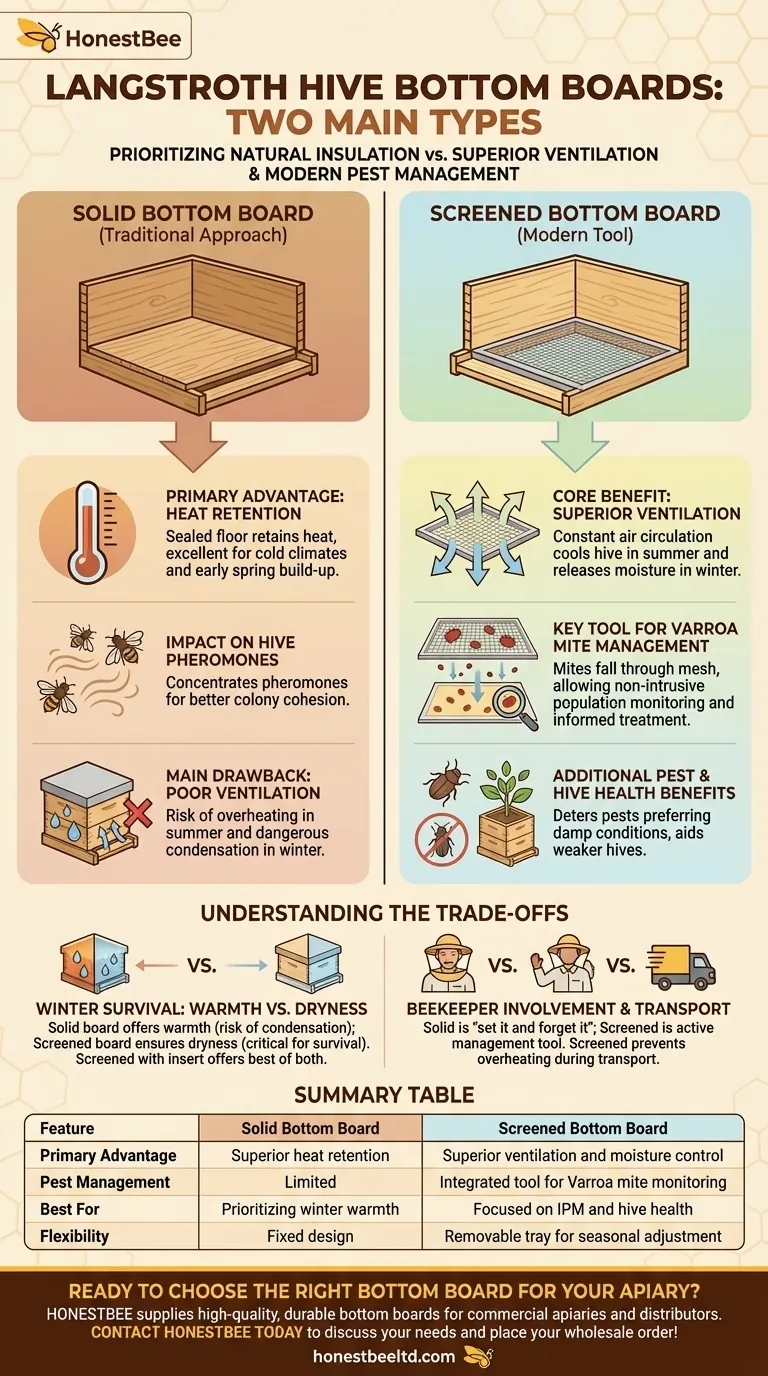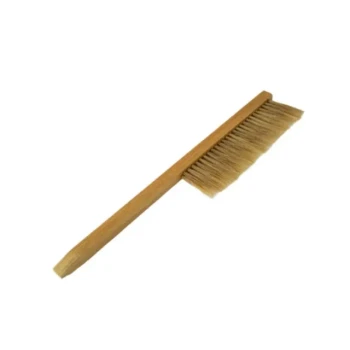The two primary types of bottom boards for a standard Langstroth hive are the solid bottom board and the screened bottom board. A solid bottom board is the traditional design, consisting of a single, solid piece of wood that forms the hive floor. In contrast, a screened bottom board replaces a portion of the solid floor with a wire mesh screen, providing ventilation and a path for debris to exit the hive.
Your choice between a solid and screened bottom board is a decision between prioritizing natural insulation and a sealed environment (solid) versus enabling superior ventilation and modern pest management (screened). The right option depends entirely on your local climate and beekeeping philosophy.

The Solid Bottom Board: A Traditional Approach
A solid bottom board represents the classic, original design for the Langstroth hive. It creates a completely enclosed, solid floor for the colony.
The Primary Advantage: Heat Retention
By creating a sealed floor, a solid bottom board is highly effective at retaining the heat generated by the bee cluster. This can be a significant advantage in cold climates, helping the colony conserve energy and stay warm through the winter.
Some beekeepers believe this warmth encourages the queen to begin laying eggs earlier in the spring, potentially leading to a faster colony build-up.
The Impact on Hive Pheromones
Because the hive is sealed at the bottom, communication pheromones remain more concentrated within the hive. This may aid in colony cohesion and communication.
The Main Drawback: Poor Ventilation
The lack of ventilation is the solid board's biggest weakness. In hot, humid summers, this can lead to overheating. In cold, damp winters, it can trap moisture from the bees' respiration, leading to condensation that can be lethal to the colony.
The Screened Bottom Board: A Modern Tool
The screened bottom board, often called an Integrated Pest Management (IPM) board, features a wooden frame with a large section of #8 hardware cloth (wire mesh). It almost always comes with a removable solid tray, often called a "sticky board" or debris tray, that can slide in underneath the screen.
The Core Benefit: Superior Ventilation
The screen provides constant, passive air circulation. This helps cool the hive during hot weather and, more critically, allows excess moisture to escape during winter, keeping the colony dry. A dry, cold colony has a much higher chance of survival than a damp, cold colony.
A Key Tool for Varroa Mite Management
This is arguably the most important function of a screened bottom board. Varroa mites, a destructive parasite, will occasionally fall off their bee hosts. With a screened bottom, these mites fall through the mesh and out of the hive, unable to return.
By placing the removable "sticky board" (often coated with oil or shortening) under the screen for 24-72 hours, you can perform a "mite drop count." This allows you to accurately monitor the Varroa mite population in your hive without intrusive inspections, empowering you to make informed treatment decisions.
Additional Pest and Hive Health Benefits
The increased light and air circulation from a screened bottom can help deter other pests, like the small hive beetle, which prefer dark, damp conditions. This ventilation is also beneficial for weaker hives that may struggle to regulate temperature on their own.
Understanding the Trade-offs
Neither bottom board is universally superior; each presents a different set of management considerations.
Winter Survival: Warmth vs. Dryness
The central debate revolves around wintering. A solid board offers more warmth, but at the risk of deadly condensation. A screened board ensures a dry hive, which is often more critical for survival than absolute warmth.
However, a screened bottom board with its removable insert offers the best of both worlds. You can leave the tray in place for most of the winter to mimic a solid board's warmth, then strategically remove it on warmer days to air out the hive and release moisture.
Beekeeper Involvement
A solid bottom board can be seen as a more "set it and forget it" component. In contrast, a screened bottom board is an active management tool that requires you to monitor mite counts and decide when to use the removable insert.
Colony Transportation
If you plan to move your hives, a screened bottom board provides essential ventilation that prevents the colony from overheating during transit, especially on warm days.
Making the Right Choice for Your Apiary
Your decision should be based on your specific goals and environmental conditions.
- If your primary focus is maximum insulation in a very cold climate: A solid bottom board offers a slight thermal advantage, but you must remain vigilant about managing winter moisture.
- If your primary focus is effective Varroa mite control: A screened bottom board is an indispensable tool for monitoring mite populations as part of an Integrated Pest Management strategy.
- If your primary focus is versatility and overall hive health: A screened bottom board with its removable insert provides the most flexibility, allowing you to manage summer heat, winter moisture, and pest levels effectively.
Understanding these fundamental differences empowers you to create an environment where your bees can truly thrive.
Summary Table:
| Feature | Solid Bottom Board | Screened Bottom Board |
|---|---|---|
| Primary Advantage | Superior heat retention for cold climates | Superior ventilation and moisture control |
| Pest Management | Limited | Integrated tool for Varroa mite monitoring |
| Best For | Beekeepers prioritizing winter warmth | Beekeepers focused on IPM and hive health |
| Flexibility | Fixed design | Removable tray for seasonal adjustment |
Ready to choose the right bottom board for your apiary?
HONESTBEE supplies commercial apiaries and beekeeping equipment distributors with high-quality, durable bottom boards designed for optimal colony health. Whether you need the insulating properties of a solid board or the advanced pest management capabilities of a screened board, we have the wholesale solutions to support your operation.
Contact HONESTBEE today to discuss your needs and place your wholesale order!
Visual Guide

Related Products
- Australian Pine Wood Langstroth Screen Bottom Board for Wholesale
- Langstroth Screen Bottom Board for Beekeeping Wholesale
- HONESTBEE Professional Frame Wiring Board and Jig
- HONESTBEE Wooden Bee Escape Board with Triangle Mesh Design for Beekeeping
- HONESTBEE Durable Frame Wiring Board with Integrated Tensioner
People Also Ask
- What additional benefit does a screened bottom board offer? Boost Hive Health & Mite Control
- What features does the screened bottom board with insert offer? Essential Tools for Hive Health and Pest Control
- How does a screened bottom board benefit the hive during the summer? Boost Ventilation & Pest Control
- Are screened bottom boards necessary for beekeeping? A Strategic Choice for Modern Hive Health
- What are the assembly options for the Cypress Screened Bottom Board? Ready-to-Use for Immediate Hive Health



















